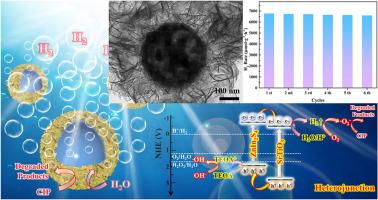基于钙钛矿的SrTiO3/ZnIn2S4中空核壳花状异质结通过双金属协同作用和界面电位调节增强光催化H2演化/降解
IF 8.3
2区 工程技术
Q1 CHEMISTRY, PHYSICAL
引用次数: 0
摘要
采用水热-退火-化学方法合成了钙钛矿SrTiO3/ZnIn2S4空心核壳花状异质结。所得的SrTiO3/ZnIn2S4异质结(SrTiO3/ZnIn2S4-3)比SrTiO3(~ 83.8/17.0倍)和ZnIn2S4(~ 21.6/4.9倍)的HER (~ 6762.86 μmol g−1 h−1)/降解(~ 0.02404 min−1)有显著提高,稳定性也较好。这主要是由于SrTiO3/ZnIn2S4异质结具有适当的电位梯度来提高载流子效率,包括增加输运、延长寿命和减少复合。此外,ZnIn2S4超薄层状结构可以改善固/液界面,增加活性位点并提供抑制光腐蚀的超短激子途径,SrTiO3中空球形结构可以提高结构稳定性,Zn/In双金属协同作用与载流子驱动可以促进载流子运输。SrTiO3/ZnIn2S4具有良好的电子/空穴动力学平衡,实现了良好的HER/降解。本文章由计算机程序翻译,如有差异,请以英文原文为准。

Perovskite-based SrTiO3/ZnIn2S4 hollow core-shell flower-shaped heterojunction for photocatalytic H2 evolution/degradation enhancement via bimetallic synergy and interface potential regulation
Perovskite SrTiO3/ZnIn2S4 hollow core-shell flower-shaped heterojunction is synthesized by an approach of hydrothermal-annealing-chemical method. The obtained SrTiO3/ZnIn2S4 heterojunction (SrTiO3/ZnIn2S4-3) shows significantly improved HER (∼6762.86 μmol g−1 h−1)/degradation (∼0.02404 min−1) over that of SrTiO3 (∼83.8/17.0 folds) and ZnIn2S4 (∼21.6/4.9 folds), including a decent stability. It primarily attributes to the SrTiO3/ZnIn2S4 heterojunction owns appropriate potential gradient to improve carrier efficiency, including increasing transport, extending lifetime, and reducing recombination. Moreover, the ZnIn2S4 ultrathin lamellar structure can ameliorate solid/liquid interface, increased active sites and provide ultrashort exciton pathway for inhibiting the photocorrosion, and the SrTiO3 hollow spherical structure can increase structural stability, as well as the Zn/In bimetallic synergy with carrier driven can promote carrier transportation. With remarkable electron/hole kinetic equilibrium, SrTiO3/ZnIn2S4 achieves decent HER/degradation.
求助全文
通过发布文献求助,成功后即可免费获取论文全文。
去求助
来源期刊

International Journal of Hydrogen Energy
工程技术-环境科学
CiteScore
13.50
自引率
25.00%
发文量
3502
审稿时长
60 days
期刊介绍:
The objective of the International Journal of Hydrogen Energy is to facilitate the exchange of new ideas, technological advancements, and research findings in the field of Hydrogen Energy among scientists and engineers worldwide. This journal showcases original research, both analytical and experimental, covering various aspects of Hydrogen Energy. These include production, storage, transmission, utilization, enabling technologies, environmental impact, economic considerations, and global perspectives on hydrogen and its carriers such as NH3, CH4, alcohols, etc.
The utilization aspect encompasses various methods such as thermochemical (combustion), photochemical, electrochemical (fuel cells), and nuclear conversion of hydrogen, hydrogen isotopes, and hydrogen carriers into thermal, mechanical, and electrical energies. The applications of these energies can be found in transportation (including aerospace), industrial, commercial, and residential sectors.
 求助内容:
求助内容: 应助结果提醒方式:
应助结果提醒方式:


